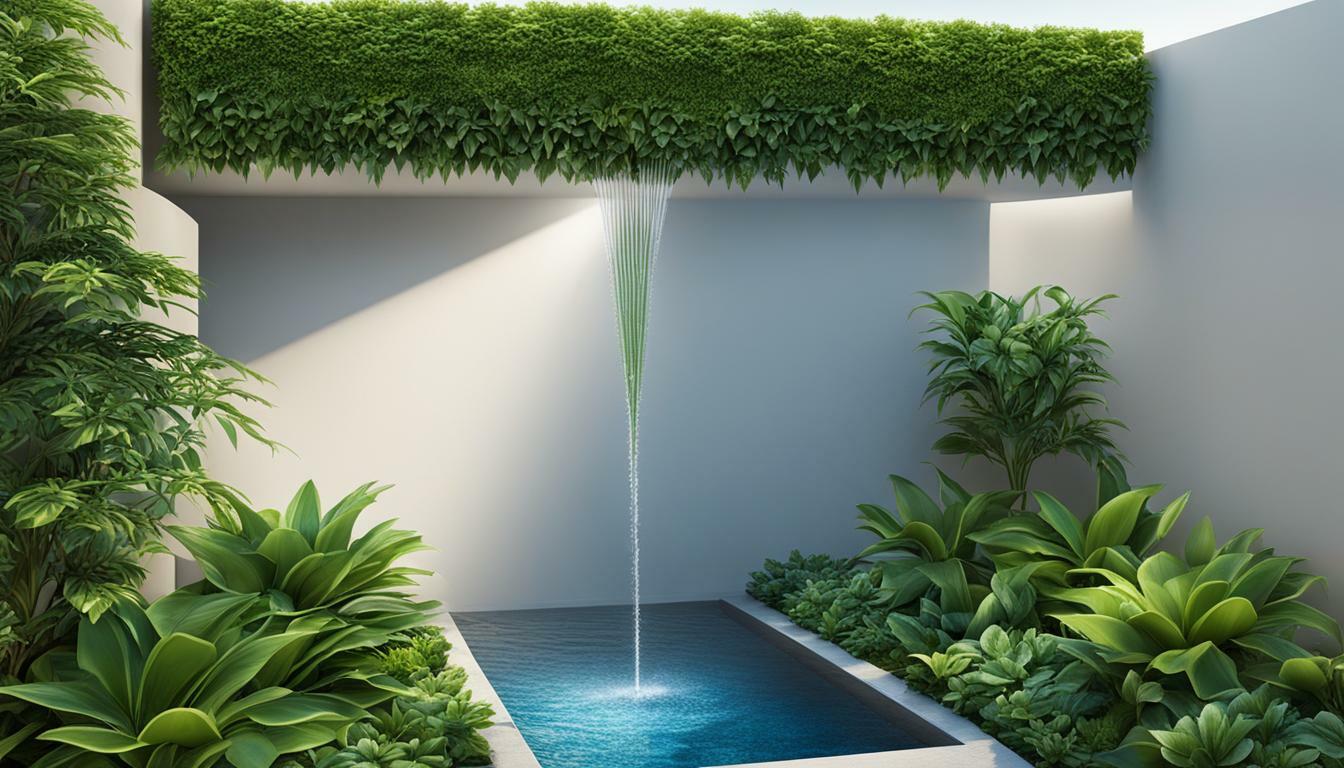- Watering a vertical garden can be as simple as using a long-spout watering can or installing a drip irrigation system.
- Manual watering and automated watering systems each have their own advantages and considerations.
- Challenges of watering a vertical garden include determining watering needs and dealing with varying sunlight conditions.
- Indoor and outdoor vertical gardens have different watering needs and considerations.
- Manual watering allows for close monitoring of plant health, while automated systems offer convenience and time-saving benefits.
- Setting up a vertical garden watering system requires considering plant numbers, water requirements, and choosing the right equipment.
- There are various watering tools and products specifically designed for vertical gardens, such as long-spout watering cans and drip irrigation systems.
- An efficient vertical garden watering system is essential for optimal plant growth and water conservation.
Why a Vertical Garden Watering System is Essential
Implementing an efficient vertical garden watering system is crucial to ensure the optimal growth and health of your plants. In this section, we will discuss why a watering system is essential and the advantages it offers.
Growing plants vertically can present unique challenges when it comes to watering. Unlike traditional gardens, vertical gardens have smaller planting pockets and looser, less water-retentive soils, which can result in quicker drying out of the soil. This is especially true when the roots are not yet developed enough to seek out and store water. Additionally, the varying sunlight conditions in different locations can further complicate watering needs. That’s why a well-designed and efficient watering system is essential for vertical gardens.
Manual watering may be an option, using tools such as long-spout watering cans. However, it requires a significant amount of time and effort to ensure each plant receives adequate water. On the other hand, automated watering systems offer several advantages. They provide convenience and save time by automatically delivering the right amount of water to each plant at regular intervals. This precision ensures that plants receive the optimal amount of hydration, preventing both overwatering and underwatering. Automated systems also allow for closer monitoring of plant health, as they can be equipped with sensors or timers to track moisture levels and adjust watering accordingly.
One popular type of automated vertical garden watering system is a drip irrigation system. Drip irrigation delivers water directly to the roots of plants, minimizing evaporation and reducing water waste. It can be set up to work with both indoor and outdoor vertical gardens. For outdoor gardens, the system can be connected to a main water source, while indoor gardens can utilize a reservoir-based system. By implementing an automated vertical garden watering system, you can ensure efficient water usage, promote healthy plant growth, and save time and effort in maintaining your garden.
Advantages of a Vertical Garden Watering System
Installing a vertical garden watering system offers several advantages to both the plants and the gardener. Here are some key benefits:
- Efficiency: A watering system ensures that each plant receives the right amount of water, preventing overwatering or underwatering. This efficient water distribution promotes healthy plant growth and maximizes yields.
- Water conservation: By using a drip irrigation system or other efficient watering methods, you can minimize water waste by delivering water directly to the roots of plants. This reduces evaporation and ensures that water is used only where it is needed.
- Time-saving: An automated watering system saves you time and effort in manually watering each plant. With a preset schedule or sensor-based system, you can set it and forget it, allowing you to focus on other gardening tasks or enjoy your garden without constant maintenance.
- Plant health monitoring: Some automated watering systems can be equipped with sensors to monitor soil moisture levels, allowing you to closely track the health of your plants. This early detection of moisture-related issues can help you adjust watering levels and address any problems promptly.
By implementing an efficient vertical garden watering system, you can ensure the optimal growth and health of your plants while promoting water conservation and saving time and effort in maintaining your garden.
| Advantages of a Vertical Garden Watering System |
|---|
|
Manual Watering vs. Automated Vertical Garden Watering System
When it comes to watering your vertical garden, you have two main options: manual watering or an automated watering system. In this section, we will explore the differences between these methods and help you determine the best choice for your garden.
Manual watering involves using tools such as long-spout watering cans or hoses to water your plants by hand. This method allows for greater control and precision, as you can directly target the base of each plant and adjust the amount of water accordingly. It also provides an opportunity to closely monitor the condition of your plants, checking for signs of pests, disease, or nutrient deficiencies. Manual watering can be a labor-intensive process, requiring time and effort on your part.
On the other hand, an automated vertical garden watering system offers convenience and efficiency. These systems use timers or sensors to automatically deliver water to your plants on a regular schedule. They can be set to provide the right amount of water at the right time, ensuring optimal hydration without overwatering. Automated systems are particularly suitable for busy individuals or those who may be away from their gardens for extended periods. They save time, reduce water waste, and provide consistent care for your plants.
Deciding between manual watering and an automated system depends on your individual needs and preferences. If you have the time and enjoy the hands-on approach, manual watering can be a rewarding experience. It allows for closer interaction with your plants and the ability to address any issues promptly. However, if you have a busy schedule or prefer a more hands-off approach, an automated system may be the better choice. It provides convenience, precision, and peace of mind knowing that your plants are receiving the proper care even when you’re not around.
Table: Comparison of Manual Watering and Automated Vertical Garden Watering System
| Factor | Manual Watering | Automated Watering System |
|---|---|---|
| Control and Precision | High – Can adjust water amount and target specific plants | Moderate – Set timers or sensors to deliver water at predetermined intervals |
| Monitoring and Plant Health | Intensive – Allows close observation and prompt action | Moderate – Requires periodic checks and maintenance |
| Convenience and Time-Saving | Moderate – Requires time and effort for watering | High – Automatically waters plants according to set schedule |
| Water Efficiency | Moderate – Water can be wasted if not controlled properly | High – Delivers precise amount of water, reducing waste |
In summary, both manual watering and automated vertical garden watering systems have their advantages and considerations. The decision ultimately depends on your individual circumstances, preferences, and the level of control and convenience you desire. Whichever method you choose, proper watering is crucial for the health and vitality of your vertical garden.
Understanding the Challenges of Watering a Vertical Garden
Watering a vertical garden comes with its own set of challenges. In this section, we will discuss the unique considerations of vertical garden hydration, including the importance of proper irrigation methods and overcoming potential issues.
One of the key challenges of watering a vertical garden is determining how much to water. With smaller planting pockets and looser, less water-retentive soils, vertical gardens can dry out quickly. This becomes even more crucial when the roots are not yet fully developed to seek out and store water. It is important to strike a balance between providing enough water for the plants’ needs without overwatering, which can be as detrimental as underwatering.
Different locations can also complicate watering a vertical garden. For example, a vertical garden in a sunny area will use water at a much faster rate than one in the shade or indoors. Sunlight affects the water needs of plants, both indoors and outdoors. When considering the watering needs of indoor plants, it is important to pay attention to the amount of sunlight they receive, as it can affect evaporation and heating of both the plants and the containers.
Manual watering is one approach to addressing the challenges of watering a vertical garden. While it requires time and effort, manual watering allows for close monitoring of plant health and the ability to address issues promptly. It also ensures the correct level of water is delivered for each plant. However, not everyone has the time or ability to manually water their garden regularly.
Fortunately, there are automated vertical garden watering systems available that offer convenience and precision. These systems can be programmed to deliver a designated amount of water directly to the roots of the plants at preset intervals. They save time and ensure consistency in watering, even when the gardener is away. While automated systems provide convenience, they can still be combined with close monitoring to address any issues that may arise.
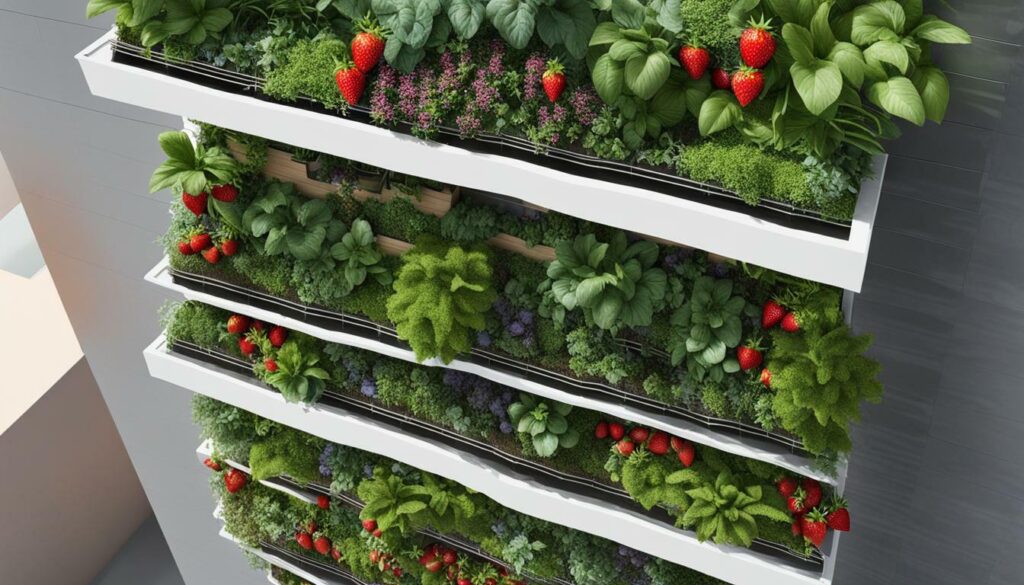
Table: Comparison of Manual and Automated Vertical Garden Watering Systems
| Manual Watering | Automated Watering |
|---|---|
| Requires regular time and effort | Offers convenience and saves time |
| Closely monitors plant health | Ensures consistent watering |
| Allows for prompt addressing of issues | Programmable for specific watering needs |
| Provides direct control over water amount | Delivers precise amount of water |
| Requires physical presence for watering | Can be programmed for automatic watering |
When setting up a vertical garden watering system, it is important to consider the number of plants and their water requirements. Each plant has specific needs, and adjustments can be made as the plants grow. The choice of watering system will depend on the size and height of the vertical garden, as well as the gardener’s preferences and available resources.
There are various tools and products available specifically designed for vertical gardens, such as long-spout watering cans and drip irrigation systems. These can help ensure efficient watering and proper hydration of the plants. Choosing the right tools and products will depend on the specific needs of the vertical garden and the gardener’s preferences.
In summary, watering a vertical garden requires careful consideration of the specific challenges posed by vertical gardening. Proper irrigation methods, whether through manual watering or automated systems, are crucial for ensuring optimal plant health and growth. By addressing these challenges and implementing an efficient vertical garden watering system, gardeners can maximize the potential of their vertical gardens while conserving water.
Indoor Vertical Gardens vs. Outdoor Vertical Gardens
Whether you are growing a vertical garden indoors or outdoors, understanding the distinct watering requirements for each setting is key to maintaining healthy plants. In this section, we will explore the specific considerations for watering indoor and outdoor vertical gardens.
Watering Considerations for Indoor Vertical Gardens
Indoor vertical gardens have their own unique complexities when it comes to watering. While the environment is more controlled and regulated compared to the outdoors, sunlight considerations still apply even indoors. Bright radiant sun beaming through a house window has the power to cause evaporation and heating of both the plants and the containers, which can affect the water needs of your vertical garden plants. Additionally, indoor temperature regulation is a crucial factor in deciding on species and watering regimes.
One popular method of watering indoor vertical gardens is through reservoir-based systems. These systems utilize a reservoir of water that is distributed to the plants as needed. The soil in the containers or pockets of the vertical garden draws water from the reservoir, ensuring consistent moisture levels. It is important to monitor the water level in the reservoir to avoid it dropping below half, as this can lead to issues with water suction and affect the overall health of the plants.
Watering Considerations for Outdoor Vertical Gardens
Outdoor vertical gardens face different challenges when it comes to watering. The weather plays a significant role in determining the watering needs of your plants. Bright sunlight and high temperatures increase the rate of evaporation and water consumption, meaning outdoor vertical gardens may require more frequent watering compared to their indoor counterparts.
One effective method for watering outdoor vertical gardens is the use of drip irrigation systems. These systems deliver water directly to the roots of the plants, ensuring efficient water usage and minimizing water loss through evaporation. By providing a consistent and controlled water supply, drip irrigation systems help maintain optimal soil moisture levels and promote healthy plant growth.
Summary
When it comes to watering vertical gardens, whether indoors or outdoors, it is crucial to consider the specific needs of your plants in each setting. Indoor vertical gardens require attention to temperature regulation and sunlight exposure, while outdoor vertical gardens necessitate more frequent watering due to higher evaporation rates. Reservoir-based systems and drip irrigation systems are effective methods to ensure consistent and efficient watering for indoor and outdoor vertical gardens, respectively.
| Watering Considerations | Indoor Vertical Gardens | Outdoor Vertical Gardens |
|---|---|---|
| Sunlight Exposure | Consider the impact of bright sunlight through windows on evaporation and heating of plants and containers | Higher evaporation rates due to direct sunlight |
| Temperature Regulation | Indoor temperature control affects watering needs | Outdoor temperature affects water consumption |
| Watering Methods | Reservoir-based systems draw water from a centralized source | Drip irrigation systems deliver water directly to the roots |
The Benefits of Manual Watering and Close Monitoring
Manual watering can be a highly effective method for maintaining a vertical garden, allowing you to personally attend to each plant’s needs and ensure optimal hydration. In this section, we will discuss the benefits of manual watering and how to implement a manual watering system for your vertical garden.
One of the main advantages of manual watering is the ability to closely monitor the health of your plants. By physically inspecting each plant while watering, you can spot signs of pests, disease, or nutrient deficiencies early on and take appropriate action. This hands-on approach allows for prompt intervention and a higher chance of successful plant care.
Addionally, manual watering provides the opportunity for targeted hydration. Different plants have varying water requirements, and by manually watering, you can tailor your watering routine to the specific needs of each plant. This precise method helps prevent overwatering or underwatering, promoting healthier growth and reducing the risk of root rot or other water-related issues.
Furthermore, manual watering allows you to adjust your watering schedule based on the changing needs of your plants. Factors such as weather conditions, plant stage, and soil moisture levels can all influence the watering requirements of your vertical garden. With manual watering, you can adapt your routine accordingly, ensuring that your plants receive adequate hydration without wasting water.
To implement a manual watering system for your vertical garden, you will need appropriate tools and equipment. Long-spout watering cans are ideal for reaching plants in higher rows or hanging positions. Consider investing in a watering can with a longer spout to make watering easier and more efficient.
In addition to a long-spout watering can, you may also need a hose attachment or wand extension for outdoor vertical gardens. These tools can help reach plants that are further away or higher up, ensuring even watering throughout your garden.
Remember to always water your vertical garden thoroughly, allowing water to reach the roots of each plant. Take note of any specific watering instructions for different plant varieties, as some may have unique needs or preferences.
Overall, manual watering can provide numerous benefits for your vertical garden. It allows for close monitoring of plant health, targeted hydration, and the flexibility to adjust watering routines as needed. By implementing a manual watering system and taking a hands-on approach, you can ensure the optimal growth and health of your vertical garden plants.
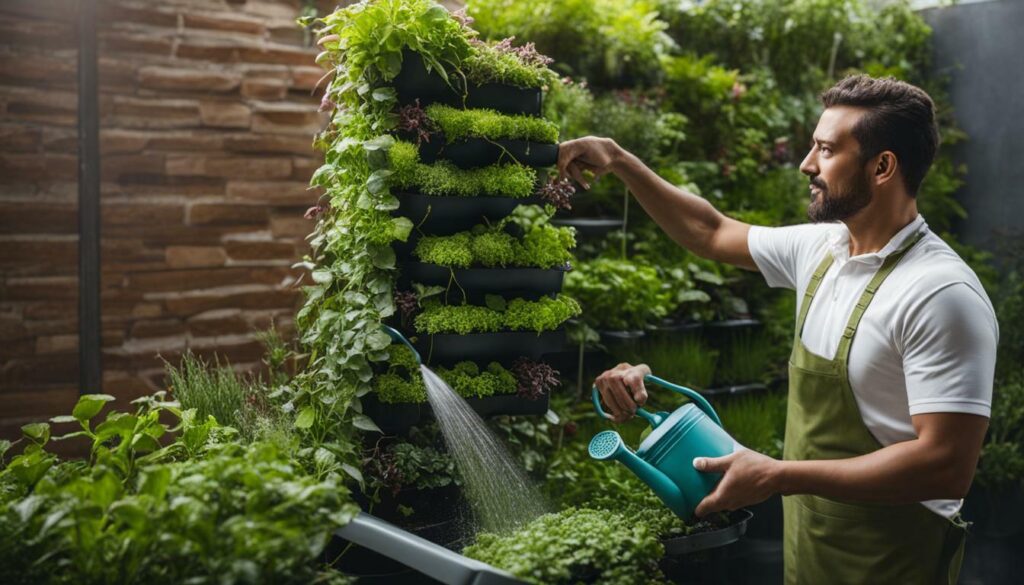
| Benefits of Manual Watering | Benefits of Close Monitoring |
|---|---|
|
|
Expert Tip:
Regularly check the moisture level of your soil to ensure that it is neither too dry nor too saturated. Stick your finger about an inch into the soil – if it feels moist, it’s adequately hydrated. If it feels dry, it’s time to water your plants. Remember, consistency is key when manually watering your vertical garden.
Now that we’ve explored the benefits of manual watering and close monitoring, you can confidently implement a manual watering system for your vertical garden. By taking a hands-on approach and being attentive to the needs of your plants, you can maximize their growth and overall health while enjoying the rewarding experience of tending to your vertical garden.
Advantages of Automated Vertical Garden Watering Systems
If you prefer a more hands-off approach to watering your vertical garden, automated watering systems offer numerous advantages. In this section, we will explore the benefits of automated vertical garden watering systems and provide guidance on selecting and installing the right system for your needs.
One of the key advantages of automated vertical garden watering systems is convenience. These systems eliminate the need for manual watering, saving you time and effort. With an automated system, you can set a schedule for when your plants need to be watered, ensuring they receive a consistent water supply without you having to remember to do it yourself. This is particularly beneficial for those with busy lifestyles or frequent travelers who may not always be available to water their plants.
Precision is another major advantage of automated watering systems. These systems are designed to deliver water directly to the roots of your plants, ensuring efficient hydration and reducing water waste. By providing precise amounts of water at regular intervals, automated systems help prevent overwatering or underwatering, which can be detrimental to plant health. This level of precision contributes to optimal plant growth and can help maximize yields in your vertical garden.
In addition to convenience and precision, automated vertical garden watering systems also help conserve water. These systems are designed to deliver water directly to the plants’ roots, minimizing runoff and evaporation. By reducing water waste, automated systems help promote sustainable gardening practices and contribute to water conservation efforts. Whether you are gardening in an urban environment with limited water resources or simply want to minimize water usage, an automated watering system can help you achieve your goals.
To set up an automated vertical garden watering system, you will need to select the right system for your specific needs. Consider factors such as the size of your garden, the water requirements of your plants, and any existing infrastructure, such as access to a water source or electricity. There are different types of automated systems available, including drip irrigation, micro-sprinklers, and smart irrigation controllers. Research and choose the system that best suits your vertical garden’s needs and your personal preferences.
Once you have selected the right system, installation is relatively straightforward. Follow the manufacturer’s instructions and consider any additional accessories or components you may need, such as timers, filters, or pressure regulators. Proper installation will ensure the efficient and effective operation of your automated watering system, providing you with the convenience and benefits of automated watering for your vertical garden.
Table: Pros and Cons of Automated Vertical Garden Watering Systems
| Pros | Cons |
|---|---|
| Convenient and time-saving | Initial cost of installation |
| Precise and efficient watering | Requires regular maintenance |
| Water conservation | May require access to water source and electricity |
| Optimal plant growth and maximum yields | May require additional accessories or components |
Automated vertical garden watering systems offer numerous advantages in terms of convenience, precision, water conservation, and plant growth. By selecting and installing the right system for your vertical garden, you can enjoy the benefits of automated watering while maximizing the health and productivity of your plants.
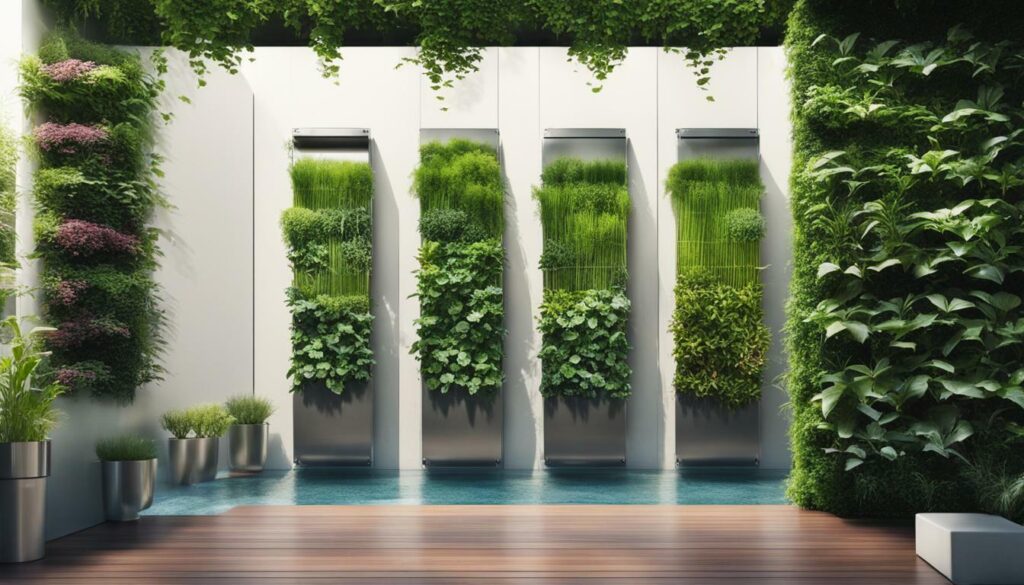
Setting Up a Vertical Garden Watering System
Setting up an efficient and effective vertical garden watering system is essential to ensure proper hydration for your plants. In this section, we will walk you through the steps of setting up a vertical garden watering system, from assessing your plant numbers and water needs to selecting the appropriate equipment.
Assessing Your Plant Numbers and Water Needs
Before setting up your vertical garden watering system, it’s important to determine the number of plants you have and their individual water requirements. Each plant has specific watering needs, so it’s crucial to understand the differences in order to provide appropriate hydration.
Most plants have similar watering requirements initially, regardless of species. However, the amount of foliage a plant produces will eventually affect its watering needs. Vines, such as watermelons, squashes, grapes, or indoor plants like Arturium or Orchids, have different watering needs compared to succulents or drought-tolerant plants. Adjustments can be made as needed to meet the specific needs of each plant.
Once you have determined the number of plants and their watering requirements, you can proceed to set up a basic watering system that is suitable for your vertical garden. For smaller plant numbers and simpler plans, regular monitoring can be sufficient to ensure proper watering. However, if you have a larger number of plants or if you prefer a more automated approach, you may consider installing an irrigation system.
Selecting the Appropriate Equipment
When selecting equipment for your vertical garden watering system, there are a few options to consider. If you prefer manual watering, a long-spout watering can may be suitable. However, keep in mind that the height and size of your vertical garden may require additional tools, such as a spraying wand extension for outdoor gardens or a watering can with a longer spout for indoor gardens.
If you opt for an automated watering system, there are various options available, including drip irrigation systems and timer-based watering systems. Drip irrigation systems are particularly effective for vertical gardens with small planting pockets, as they deliver water directly to the roots of the plants. These systems can be connected to a main water source for outdoor gardens or use a reservoir-based system for indoor gardens.
Whichever watering system you choose, ensure regular maintenance and monitoring to avoid clogged emitters or issues with the water supply. Proper maintenance will help keep your vertical garden healthy and thriving.
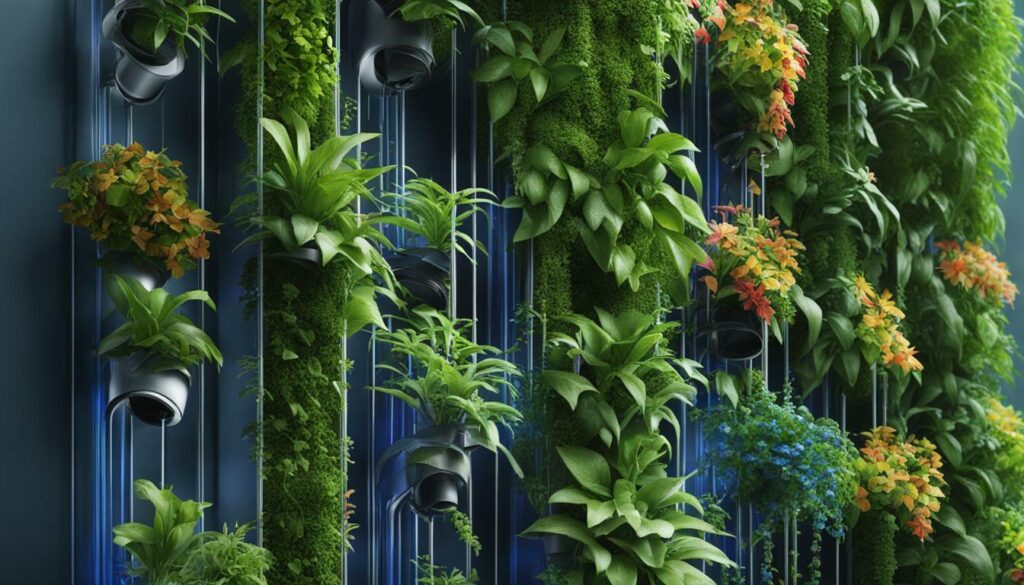
| Watering Tools and Products for Vertical Gardens |
|---|
| Long-spout watering can |
| Drip irrigation system |
| Spraying wand extension |
| Reservoir-based watering system |
Remember, the key to a successful vertical garden watering system is to assess your plant numbers and water needs, and select the appropriate equipment that meets those requirements. Whether you choose manual watering or an automated system, regular monitoring and maintenance are essential to the health and vitality of your vertical garden.
Watering Tools and Products for Vertical Gardens
When it comes to watering your vertical garden, having the right tools and products can make a significant difference in maintaining proper hydration. In this section, we will introduce you to some essential watering tools and products for vertical gardens, including long-spout watering cans and drip irrigation systems.
One of the most basic and widely used watering tools for vertical gardens is a long-spout watering can. These cans have an extended spout that allows you to reach plants in higher rows without straining or needing a step stool. They are particularly helpful for outdoor vertical gardens or larger indoor installations where accessibility can be a challenge. Long-spout watering cans come in various sizes and capacities to suit different garden sizes and watering needs.
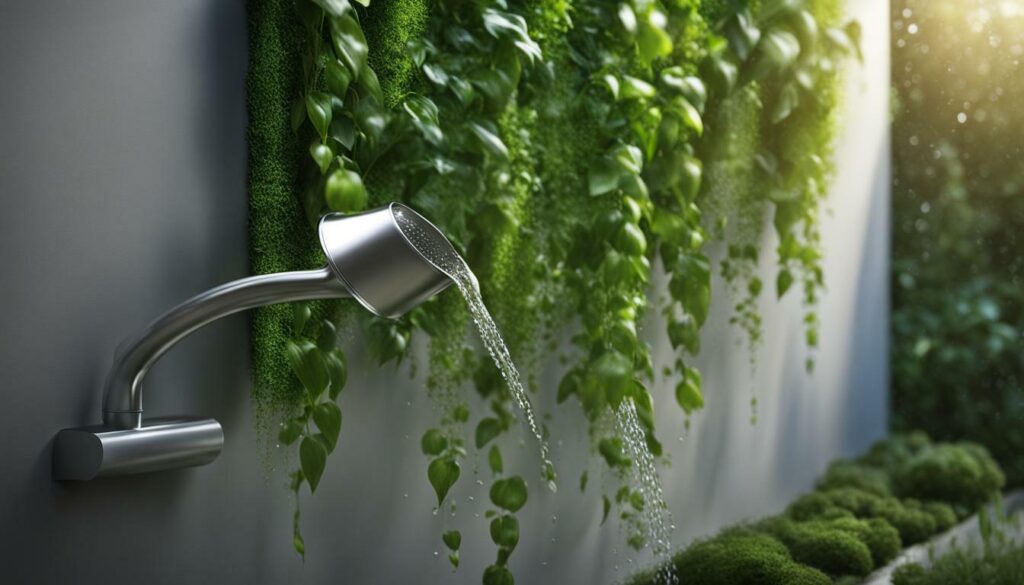
Drip irrigation systems are another popular choice for vertical gardens. These systems deliver water directly to the plant’s roots through a network of tubes and emitters. They provide a consistent and controlled water supply, ensuring that each plant receives the right amount of hydration. Drip irrigation systems can be set on timers or controlled manually, allowing for flexibility and convenience. They are especially beneficial for larger vertical gardens and for gardeners who want to automate the watering process for efficiency.
When choosing a watering tool or product for your vertical garden, consider factors such as the size of your garden, the number of plants, and your personal preferences. It’s important to select tools that are comfortable to use and efficient in delivering water to your plants. By investing in the right watering tools and products, you can ensure optimal hydration for your vertical garden and promote healthy plant growth.
How Can I Water My Vertical Tomato Garden Efficiently Using the Vertical Garden Watering System?
Maximizing tomato yield with vertical garden is easy with a vertical garden watering system. Simply set up a drip irrigation system, ensuring each plant gets enough water. Use a timer to automate watering and prevent over or under-watering. This efficient method saves time and ensures healthy, thriving tomato plants.
Can the Efficient Vertical Garden Watering System also be used for a Vertical Hydroponic Herb Garden?
Yes, the efficient vertical garden watering system can also be used for a vertical hydroponic herb garden. This system allows for easy and precise watering of herbs grown in a vertical setup, ensuring that each plant receives the right amount of water and nutrients for optimal growth in a hydroponic environment.
Conclusion
In conclusion, implementing an efficient vertical garden watering system is crucial for maximizing yields and conserving water in your urban green spaces. By carefully considering the watering needs of your vertical garden and choosing the right watering method, you can ensure the health and vitality of your plants while minimizing water usage.
Watering a vertical garden may seem like a daunting task, but with the right tools and techniques, it can be simplified and made more efficient. Whether you opt for manual watering or automated systems, both have their advantages and can be tailored to suit your needs.
Manual watering allows for close monitoring of plant health and the ability to address issues promptly. It also provides the opportunity to establish a routine and maintain a personal connection with your plants. On the other hand, automated watering systems offer convenience, precision, and the ability to save time and water.
When setting up a vertical garden watering system, consider factors such as the number of plants, water requirements, and available resources. Choose the appropriate tools and equipment, such as long-spout watering cans or drip irrigation systems, to ensure even and efficient water distribution.
By implementing an efficient vertical garden watering system, you can create a thriving and sustainable green space that not only enhances the aesthetic appeal of your surroundings but also contributes to a healthier environment.
FAQQ: Why is a vertical garden watering system essential? A: A vertical garden watering system is essential because it maximizes yields while conserving water in urban green spaces. It ensures efficient use of water and promotes healthy plant growth.Q: What are the benefits of using an automated vertical garden watering system? A: An automated vertical garden watering system offers convenience, precision, and the ability to save time and water. It ensures consistent and adequate watering for optimal plant health.Q: What are the challenges of watering a vertical garden? A: Some challenges of watering a vertical garden include determining how much to water, setting up a regulated watering system, and dealing with varying sunlight conditions. Overwatering and underwatering can both be detrimental to plant health.Q: What are the advantages of manual watering and close monitoring? A: Manual watering allows for intimate attention to plant health and the ability to address issues promptly. It also ensures the correct level of water is maintained. Close monitoring helps detect and address problems early on.Q: How do I set up a vertical garden watering system? A: To set up a vertical garden watering system, consider the number of plants you have and their watering requirements. Choose a system suitable for your needs, such as drip irrigation, and ensure the plants have enough water to thrive.Q: What are some recommended watering tools and products for vertical gardens? A: Long-spout watering cans and drip irrigation systems are recommended watering tools for vertical gardens. They allow for precise watering and ensure water reaches the roots effectively.Q: Can I use an automated watering system for an indoor vertical garden? A: Yes, an automated watering system can be used for indoor vertical gardens. It provides convenience and ensures consistent watering, even when you are not at home.Q: How do I determine the watering needs of my vertical garden? A: The watering needs of a vertical garden depend on factors such as plant species, soil type, and sunlight exposure. Start with regular watering and adjust as needed based on the moisture level of the soil.Q: What are the benefits of an efficient vertical garden watering system? A: An efficient vertical garden watering system maximizes plant growth, conserves water, and promotes sustainability. It helps create a thriving and visually appealing vertical garden.Q: How often should I water my vertical garden? A: The frequency of watering your vertical garden depends on various factors such as plant species, weather conditions, and the moisture level of the soil. Regularly check the soil moisture and adjust the watering schedule accordingly.Q: What are the advantages of using a reservoir-based watering system for an indoor vertical garden? A: A reservoir-based watering system for an indoor vertical garden provides a consistent water supply and helps maintain the moisture level of the soil. It is a convenient and effective way to water indoor plants.Q: Can I use a gravity-fed drip irrigation system for a vertical garden? A: Yes, a gravity-fed drip irrigation system is suitable for vertical gardens, especially those with small pockets or limited soil space. It ensures water drips directly into each pocket, keeping the soil moist and avoiding wastage.Q: How can I maintain my vertical garden watering system? A: Regularly check and clean the emitters of your watering system to prevent clogging. For reservoir-based systems, ensure the water level remains at least half full to maintain proper suction. Regular maintenance will keep your watering system functioning effectively.Q: What are some design tips for vertical gardening? A: When designing a vertical garden, consider the available space, sunlight exposure, and the type of plants you want to grow. Choose suitable vertical structures and supports such as trellises, caging, or staking. Experiment with different techniques and structures to create a visually appealing and functional garden.Q: How can I save water when watering my vertical garden? A: To save water when watering your vertical garden, use an efficient watering system such as drip irrigation. Regularly monitor soil moisture to avoid overwatering, and consider using recycled or harvested rainwater to irrigate your garden.Q: Can I grow a vertical garden indoors? A: Yes, you can grow a vertical garden indoors. Indoor vertical gardens are a great way to maximize limited space and add greenery to your home or office. Use appropriate lighting and choose plants that thrive indoors.Q: Is manual watering or an automated system better for a vertical garden? A: The choice between manual watering and an automated system depends on your preferences, time availability, and the size of your vertical garden. Manual watering allows for close monitoring and attention to plant health, while an automated system offers convenience and precise watering. Consider your needs and requirements before deciding on the best approach.Q: How can I ensure proper hydration for my vertical garden? A: To ensure proper hydration for your vertical garden, regularly monitor the moisture level of the soil and adjust the watering schedule accordingly. Consider using a well-designed watering system that delivers water directly to the roots of the plants.
